Today’s online art business has been spiraling up year over year. An artist no longer needs a shop in order to sell creations. This is why the art business done online has grown huge and better. For instance, in joining Art Classes La Jolla, you will soon be selling your artworks on websites like Artfinder and Shopify. When an artist used torequire a concrete gallery to display his artworks, the replica watches online page offering a similar view of what is being sold has replaced it.
Now, having an online art shop is one thing, and promoting it via the social media is another. Proven and tested,this is really a good leverage in maximizing the social network and boosts your sales among others. When you have Facebook, Pinterest, and Twitter, your online art business gallery has a greater chance of going to sell out than those who don’t and stick to the conventional manner of art shop. Here is How Social Media Can Be Useful in Maximizing Art Selling:
- Sign Up
This is the very first thing before you hit the go signal. Quickly fill-out an online form for you to get started. Make sure you have your contact information correct and in detail.
- Create A Profile
This includes your task of pinning a profile photo which will make people think of it as a trademark whenever somebody brings it up in an online conversation.
- Upload Photos
The best part of it is seeing your art pieces uploaded. You can personalize your photos by leaving watermarks, so as to ensure privacy is maintained.
- Find Friends
The part where you would look for prospective buyers and possible customers is here.You can invite as many clients as you want and you do that by finding friends.
- Update Regularly
You should always make it a point to answer all queries your online shop has, and this is when you encounter customers which are almost similar to actual gallery visitors.
Now you might be wondering which among these sprouting social media networks would be perfect for Art Selling. You cannot simply add it up in any social media. You will likely lose control of your shop when this happens. You can simply have it in Shopify or Artfinder. There are other media selling art pieces so it would be up to you to look it out. Now how do you maximize other social media websites in case you are not satisfied with the art pages? Here’s how:
Every time people online will search for the hashtag item you pointed out, these online searches will be directed to your page. That is an almost free advertisement. This is something that you need not pay at all.
The future of your business depends on how you have created your profile. If you have created a winning page, then your success in online business has just started. You can start with a good name, a good URL and great pinned images.
- Share a Gallery of the Most Popular Art
Do not limit your page to your works, especially if you have just very few. Use your initiative and be articulate in creating a good conversation to start the interest of your buyers. For instance, you can share a famous art as long as you are taking credit to the owner.
- Host and Promote Online Events
That calendar and events tab in your social media network is there for a reason. You can host an online event and promote whatever it is that you would want noticed. This is the fastest you can sell your artworks out.
Social Media is here to last so it is but just practical for you, if you have art pieces to sell, to take advantage of it while it is trending in the society and the buying public. You will have a wider target audience with this plus you will have a better income.
An unexpected excursion forced me to travel light, so in impromptu fashion I grabbed a Kuretake Waterbrush, 2B pencil, Pentel brush pen, a Faber-castell 0.5 ink pen and W&N watercolour pan, the hardened type you have to scrub at to release the pigment. I also took an inexpensive leather bound sketchbook, hand-made somewhere in the Orient; it had been gathering dust for years, and never used. None are materials I particularly use, but as I was off in a rush I figured all you really need is a pen or pencil, and if the opportunity arose, I might be able to fill the waterbrush up and add some tone.
I wasn’t headed for anywhere particularly interesting, and with no real option for getting out and about (no car, and terrible weather), so I quickly printed off several thumbnail sized paintings I liked from various artists onto a couple of sheets of paper, folded them up, placed them into the sketchbook and went on my way.
The first of the small sketches was after German Expressionist Ferdinand Hodler. I drew directly with the faber-castell pen (I have no bias for this brand, it’s just what I had to hand) in a gestural fashion; it helps keep things loose. The paper isn’t really made with watercolour in mind, but it’s thick enough to accept a few washes – 2 or 3 are enough to get a good simplified range of light to darks. You can never be too sure how the paint will finish up when mixing a waterbrush into a pan, but it’s easy enough if you’re aiming for dark, medium and light. If something is too dark, you can always dab at it with a tissue, or water it down (and dab at it with a tissue) to lighten it.
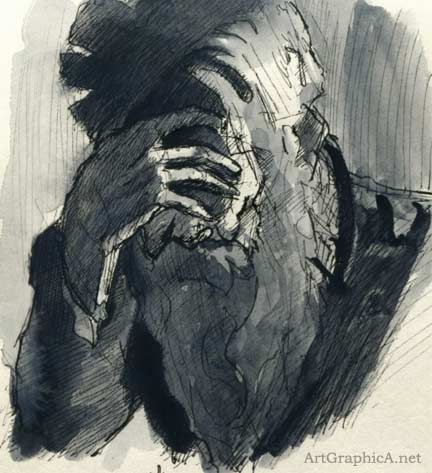
Larger Version: Ferdinand Hodler sketch
The Venetian architectural sketch was inspired from a watercolour by John Singer Sargent. Again very loose, trying to keep basic perspective in mind. The watercolour pan is not labelled, so I’m guessing it is lamp black; it tends towards a bluish tint.
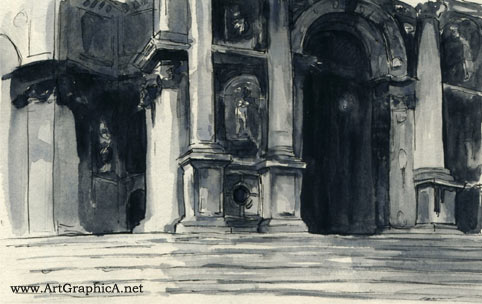
Larger Version: John Sargent Venice Sketch
These thumbnail sketches are after Childe Hassam if my memory serves correctly, and again John Sargent (on the right). The Childe inspired sketch was with the Pentel brushpen and Sargent with the Faber-castell. The size of it made the horse and figure a little fiddly because the only way to get a fine line is to hold the brushpen in a very vertical position with only the lightest of touches against the paper. If you work too often like that it is easy to lose the intent and looseness of a sketch.
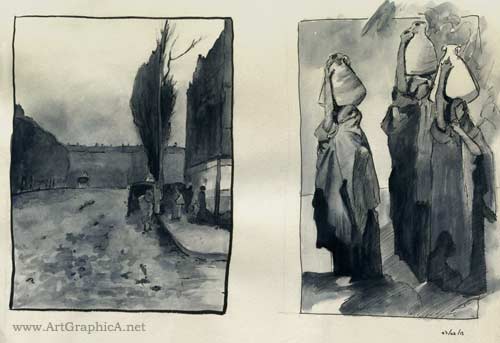
Larger Version: Childe Hassam and John Singer Sargent sketches
Last are some Pentel brushpen with wash sketches, which I believe are after Soralla (figure with bridge), though sadly the bottom one of the lady in the formal garden alludes me at present. It might be James Tissot, but don’t quote me on that. In the Sorolla that sense of downhill perspective to the bridge is achieved by keeping the vanishing point below the horizon line; if you put it above the horizon line you can achieve the illusion of something going uphill – basic perspective 101.
The brushpen keeps everything loose and jiggly and it’s easy to go from a fine edge to a fat one. By using the waterpen almost sideways on, you can cover large areas quickly to try and simplify the masses of shadows and light. Anything that’s a little smaller, such as the figures can be toned with a slightly more vertical grip.
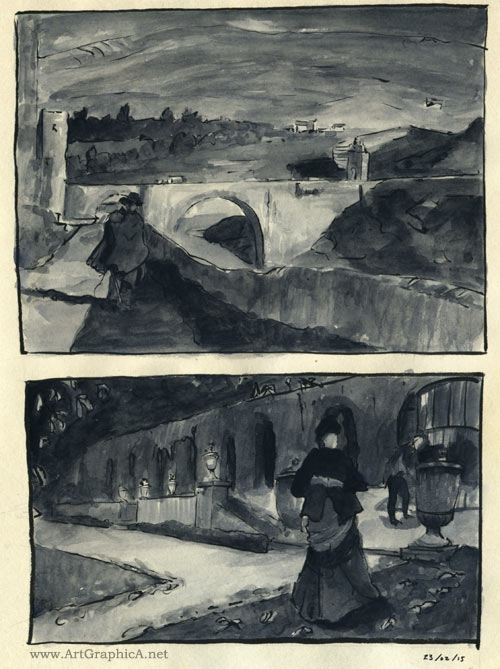
Larger Version: Sorella and Tissot
Thomas Eakins (1844 – 1916) is ordinarily known for his realistic portraits. He studied in Paris at the École des Beaux-Arts under French artist Jean-Léon Gérôme, and spent a brief spell with Léon Bonnat.
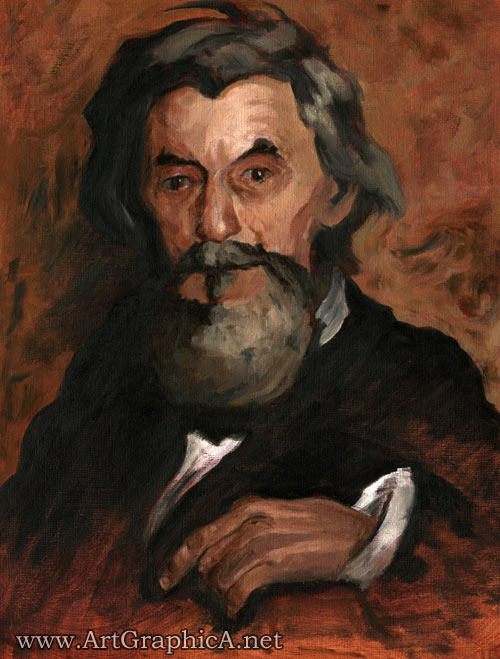
Portrait after Thomas Eakins, 30cm by 40cm.
In 1891 Eakins painted a portrait of his father-in-law, William H. Macdowell, an engraver from Philadelphia. It was 71cm by 55cm in size and he may well have simply considered it a sketch or study. The stylish pose of a long face on a pyramidal body created with liberal brushstrokes creates an impressionistic mood to the painting, and an expression that is sometimes lost within his more realistic renderings.
For years I have been doing sketches with pencil and charcoal, never breaking into colour and oils other than half a dozen experiments in my early days of learning to draw. I had bought numerous tubes of paint in those days, left virtually unused. When the stiffened tops left my fingers bleeding, I wrenched them open with pliers, scraped out caked paint from the tube ends, and was happy to find them still usable.
The study was carried out on a 30cm by 40cm canvasboard, toned with transparent oxide red. I rarely go in with the aim of an exact study; my goals are to capture some of the expression and to learn how to mix and apply paint. The Rembrandt transparent oxide red dictated the skin tones, which meant many more warm reddish tones to Eakins earthy colours and yellow ochre and raw umbers. Thomas Eakins also carried off a thick sculptural appearance with his paint which I sadly failed to emulate; in part because I cannot afford big tubes of paint, but also due to a lack of experience in dealing with thick impasto layers which can be hard to control.
The alla prima study was done in two afternoon sessions. A turpentine thinned layer was put down, with lines to mark the general placement of the head, suit and hand. The next stage was to block in the large major shadow shapes. The initial thin layers meant it was far easier to add thicker paint applications over the top. The lighter areas are done towards the end, with more paint on the brush for the highlights, and no medium to thin the paint.
On those busy days where commitments distract you from your passion, I always like to find time for at least one small sketch. Urban sketches never used to appeal to myself, but then I had a disdain of cities before Paris changed my persuasion. Part of the appeal of sketching the city is that rather than focus on a subject close up, you can encapsulate an entire environment from street alley to panoramic view. It combines figures with landscape and architecture, bringing each into a balance and harmony.
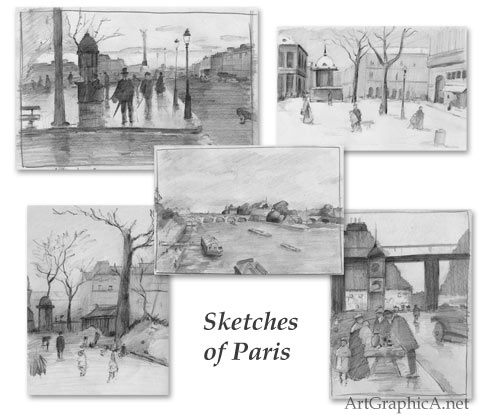
Click to Englarge: Sketches of Paris.
When pressed for time I tend to base my sketches from old oil paintings, although occasionally I will sketch from photographs in the evenings before I hit the pillow. The Paris sketches are done on A4 copy paper folded in half (17cm by 12cm or approximately 7in by 5in) – working small means you can draw more quickly.
I usually start by establishing the horizon line and vanishing points first, then sketch freehand, mostly with the edge of a pencil (a Mars Lumograph or Koh-i-noor, sharpened with a craft knife, but a point that is not overly sharp). If I am not too tired, some rough values can be ‘scrubbed’ in with an overhand grip.
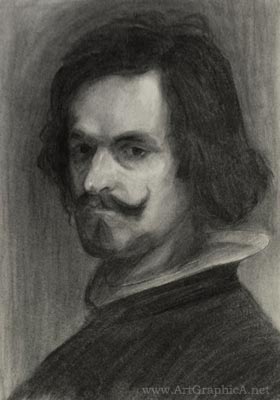
Between the rack and the Judas chair (not one to look up if you’re at all squeamish), the Spanish Inquisition were people you didn’t want to mess with. Diego Velázquez was either fearless or felt protected when he set about painting from live nude models. Only his ‘Rokeby Venus’ survives today.
Velázquez (or Velasquez as the Brits liked to spell it up until the 19th century) proved to be a great source of inspiration to artists such as John Singer Sargent, who would have been introduced by his Spanish teacher Carolus-Duran.
Following the Sargent Pen and Ink study, I drew a smallish study of Diego’s ‘Portrait of a Man’ in vine charcoal, and took a few work in progress photographs so as to create a tutorial. It’s now available online, so for anybody who is interested, please take a look : Velazquez, Portrait of a Man
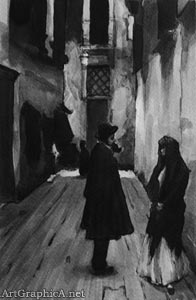 Yesterday, I decided to do another of my thumbnail sketches, but planned to make it a little larger and add more mid-tones using ink washes with a brush. I took a few photographs at different stages in case it didn’t completely belly flop, and ended up creating a small tutorial for anyone interested: Ink Study after John Singer Sargent.
Yesterday, I decided to do another of my thumbnail sketches, but planned to make it a little larger and add more mid-tones using ink washes with a brush. I took a few photographs at different stages in case it didn’t completely belly flop, and ended up creating a small tutorial for anyone interested: Ink Study after John Singer Sargent.
I’m currently out in the French countryside, where it is hot and humid. There’s a mouse scratching somewhere behind the plasterboard where I’m sat, and for every few strokes of the pen, a persistent fly insists on landing on my drawing hand, causing involuntary tics. Half-way through the short study, a tic of a different kind has embedded itself into my young daughter’s belly, and has to be teased out and executed. I’ve been told it’s best to keep the bodies in a bag in the fridge, in case Lyme disease takes hold. I’ve no penchant for the insect world, I mistrust anything with an exoskeleton!
I remember tranquil evenings sat on Paris’ Pont des Arts bridge, outside the Louvre, with picnic laid out and wine to hand. I had no family commitments then, and sat amongst numerous Parisians and tourists watching the sun set over the Seine, as the surrounding limestone architecture turned golden. It saddens me to think that this is no longer a possibility. Not only is the view totally obscured, but the bridge temporarily closed in May when a section of it fell down (fortunately without any serious consequences). The reason behind it is padlocks (aka ‘love locks’).

Photo Credit: Lolwaro974
There are a lot of strange little traditions, not just limited to Paris. There’s the playful space invader mosaics that can be discovered across all the arrondissements, or visit the Pere Lachaise cemetery and see the worn groinal area of Victor Noir’s tomb, which long ago became a fertility symbol; or Oscar Wilde’s grave, covered in lipstick kisses. I noticed the first few padlocks appearing four or five years ago, and then the concept went viral. It’s a tradition akin to carving initials into a tree, or throwing a penny into a well, seemingly harmless enough, but evidentially damaging to an iconic landmark and an eyesore when the phenomena got out of hand.
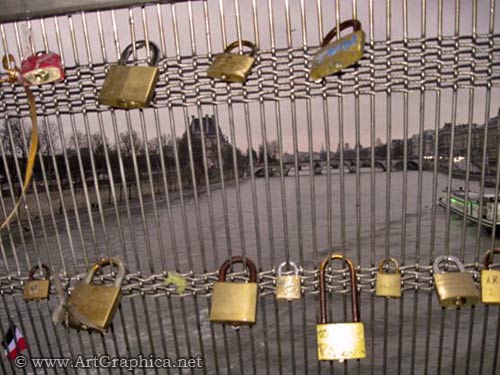
One of the founders against the love locks stated: “It’s not about romance any more – it’s just about saying, I did it.” The statement summarises my lament over the tourist experience. Of course I have to generalise, and risk sounding like an old stick in the mud, but when I visit museums like the Louvre, you can’t help but notice swarms of people make a beeline straight to Da Vinci’s Mona Lisa. If you’re not careful it’s easy to get swept up into a giant V, bottlenecking towards this tiny painting kept behind glass whilst swallowed up by bodies and assailing arms, thrust upwards with cameras and tablets all wanting the ‘I did it’ experience. By the time you reach the painting you’re instantly ushered away from it. Fortunately, just outside of the room, in the adjacent corridor hangs some wonderful Da Vinci’s, every bit as tantalising, which can be viewed to your heart’s content with little interruption.

Photo Credit: Fabrizio Sciami
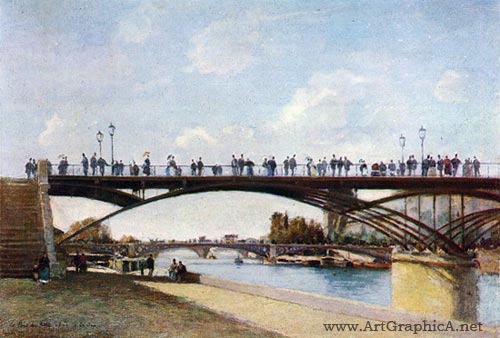
Pont des Art by Stanislas Lépine.
ArtGraphica has just released another art book, this time a chronology of American artist John Singer Sargent, following his life, paintings and personal correspondences with such friends as Claude Monet.
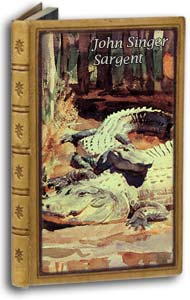
Amongst the anecdotes is a retelling of an incident that occured in England, when John Sargent innocently rode his horse through a wheat field to get to a bridle path. The incensed farmer took grave exception and started verbally abusing Sargent who had already dismounted from his horse and was apologising to the man. Sargent could say nothing to appease the farmer, so continued on to the bridle path. The incident, and sense of injustic ate away at him to the point that he took a few boxing lessons and turned up at the farmer’s door. Like a scene from Fawlty Towers, Sargent banged on the door, and demanded the farmer come outside and prepare himself for a damn good thrashing! This was no idle threat, as records report that Sargent had to pay the farmer 50 pounds in compensation for the assault upon him.
For those interested in Sargent’s technique and thoughts on painting, I have assembled a few notes below, but the best information comes from an account by a John Collier. The full text to this account can be found here : John Sargents Painting Technique.
John Singer Sargent was taught by Carolus Duran (of Spanish descent), who insisted Sargent study Velasquez. From this, Sargent learnt how to simplify, beginning with the middle-tone, working up to the darks before dealing with the brightest lights and darkest shadows and accents. Sargent once stated : “If you work on a head for a week without indicating the features you will have learnt something about the modelling of the head.” Whilst his work may appear ‘simple’, and spontaneous, John Sargent was known to repaint heads up to a dozen times if he was not happy, such was his quest for perfection.
He was once asked how to avoid false accents, to which he responded: “You must classify the values. If you begin with the middle-tone and work up from it towards the darks — so that you deal last with your highest lights and darkest darks — you avoid false accents. That’s what Carolus taught me. And Franz Hals — it’s hard to find anyone who knew more about oil-paint than Franz Hals — and that was his procedure. Of course, a sketch is different.
To Miss Heyneman who was seeking advice from him, he said: “Begin with Franz Hals, copy and study Franz Hals, after that go to Madrid and copy Velasquez, leave Velasquez till you have got all you can out of Franz Hals.”
When discussing genius in painting he said that the four painters who in his opinion possessed it in a superlative degree were Rembrandt, Titian, Tintoretto and Raphael, and upon Velasquez being suggested, added that no painter exceeded Velasquez in technical skill, but that he was less gifted in his power to interpret “spiritual qualities.”
Never leave ” empty spaces,” every stroke of pencil or brush should have significance and not merely fill in… copy one of the heads by Franz Hals in the National Gallery, then you will get an idea of what I mean by leaving no empty spaces in modelling a head, work at the fine head of the old woman rather than the superficial one of the man, I will come there and give you a criticism and haul you over the coals.
Sure enough a few days later he appeared at the National Gallery, stating “Don’t concentrate so much on the features… they are only like spots on an apple… paint the head… now you have only nose, mouth and eyes.”
His criticisms were often trenchant. “That’s not a head,” he would say, “that’s a collection of features.” “That’s not a shadow, that’s a hole, there is light in the darkest shadow.” But though often severe, he never discouraged.
Other titbits of information include:
“You want plenty of paint to paint with.”
He put out enough paint so it seemed for a dozen pictures. “Painting is quite hard enough” he said “without adding to your difficulties by keeping your tools in bad condition. You want good thick brushes that will hold the paint and that will resist in a sense the stroke on the canvas.”
To read the book in full, please see this link : John Singer Sargent
I purchased some Strathmore Bristol (vellum surface) 400 series, for the first time, which is not quite so readily available in Europe. It does state it is not suitable for watercolours, but I thought I’d try it with just a few washes. This 18cm by 10cm sketch is from a section of a Luigi Loir painting set in Paris. I used Winsor & Newton designer gouache (permanent yellow deep, yellow ochre, ivory black and zinc white), and just a touch of Daler-Rowney watercolour. I’ve only used gouache a couple of times before today, but I’m starting to enjoy it. Incidentally, Luigi Loir was a master with gouache. I watered down the paint for the most part so that the pencil shows through. Where the opaqueness of the gouache covered the pencil too much, I touched things up a little with a Wolff’s carbon pencil.
The paper took the watercolour and gouache washes quite well. If you mess about too much, it does pull the paint off a bit, but for sketching and simple washes it’s a nice resilient paper with very little in the way of texture.
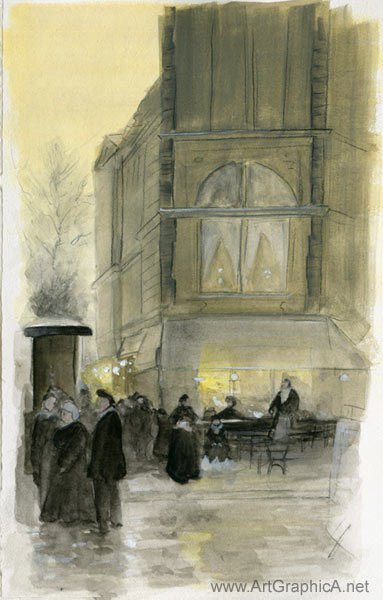
Following the previous Anders Zorn sketch, another small study was undertaken using Strathmore 500 charcoal paper, panpastel and charcoal to try and get a painterly effect. It was drawn yesterday afternoon, with photographs taken during the progress so that I could share the techniques in a tutorial.
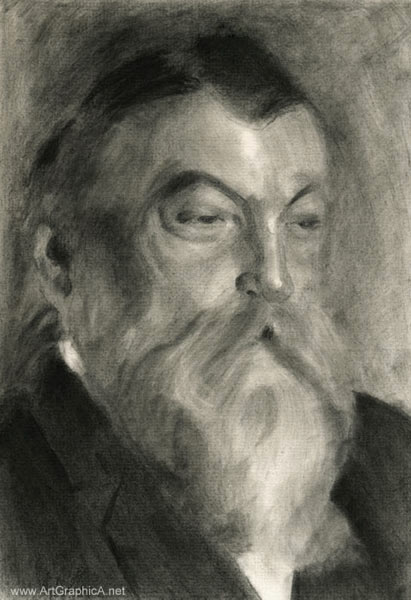
The original painting – A Toast in the Idun Society – features a number of historical figures, but the prominent fellow enjoying his drink and cigar was Harold Wieselgren who was a well-known Swedish humourist. He certainly looks like he knows how to have a good time.
For those interested, the tutorial can be seen here: Anders Zorn Portrait Drawing.















